David Osborne recently predicted academic doom for red states having recently passed universal private choice programs. “This will accelerate the process of the rich getting richer while the poor fall further behind,” Osborne asserted. Osborne problematically ignored our nation’s actual experience with universal choice programs, making his column more a litany of faith than a clear-eyed analysis.
Osborne predicts a bleak future for states with universal private choice programs, with poor families left behind. Osborne prefers a charter school model of choice, keeping choice within the public realm of regulation and accountability:
"Is there an alternative, other than the status quo of struggling public school systems? Indeed there is. States and school districts could reduce bureaucratic controls, empower educators and increase choice, competition and accountability for performance within the public school system, through the spread of charter schools. Cities that have done so, including New Orleans, Washington, D.C., Denver and Indianapolis, have produced some of the nation’s most rapid improvements in student performance."
Arizona lawmakers created the first universal private choice program in 1997, the nation’s first scholarship tax credit program. Decades passed before another state enacted a private choice law with equally expansive eligibility. Three years earlier, in 1994, Arizona lawmakers had created two de facto public universal choice programs in the nation’s most robust charter school law and a statewide district open enrollment statute. “Large” and “relatively lightly regulated” would accurately describe Arizona choice programs, both public and private. Arizona lawmakers expanded and supplemented scholarship tax credits repeatedly; the Arizona charter sector became the largest among states, and open enrollment between and within districts dwarfed both in combination. Arizona created the nation’s first education savings account program in 2011 and expanded eligibility several times before making it universally available to Arizona K-12 students in 2022.
Given Osborne specifically cites four jurisdictions with the sort of choice programs of which he approves- Denver, Washington D.C., New Orleans, and Indianapolis, it seems in order. The Stanford Educational Opportunity Project provides academic growth data by jurisdiction (schools, counties, and states) and student subgroups for the 2009-2019 period. Comparing the rate of academic growth for low-income students in each of these four jurisdictions with those of Arizona counties in Figure 1:
Academic growth is a very important academic measure. While raw scores are very strongly correlated with student demographics, growth is much less so. Scholars widely view academic growth as the best measure of school quality. Many years into exposure to universal choice programs, Arizona’s low-income students seemed to be too busy learning to suffer Osborne’s predicted calamities. Greenlee County is a rural and remote area of Arizona with approximately 1,500 students and (alas) no charter or private schools during the period covered by the data. In this measure, a “zero” basically entails having learned a grade level worth of material per year on average, so the performances for Denver, DC and Orleans Parish are respectable, Marion County (host county of Indianapolis) less so.
The Stanford Educational Opportunity Project also measures the gap in learning rates by subgroup, which is measured by subtracting the learning rate of poor students from that of non-poor students. The four jurisdictions lauded by Osborne ranked first, second, third, and fifth in comparison to Arizona counties in terms of the amount of learning rate inequality between poor and non-poor students. There was exactly one state that had a positive rate of academic growth for both poor and non-poor students and had a faster rate of academic growth for poor students. It is the state marked “1” and spoiler alert…it is Arizona, the host of multiple universal choice programs.
Osborne’s hypothesis held that what some would regard as wild, lightly regulated “let it rip” choice programs would prove to be a disaster for low-income students, and conversely, well-regulated choice programs should advantage the poor. In practice, however, we find evidence to support the opposite conclusion. These results would not have surprised Milton Friedman in the least:
The results in the above figure also sit comfortably with the diagnosis of John Chub and Terry Moe, who identified politics as the central flaw of the American public school system. The American public school system does not do a terrific job on average in educating students, but it does a fantastic job in maximizing the political power and revenue of employee unions and their associated fellow travelers. Attempting to set up a governance structure of politically disinterested technocrats who will give families just the right amount of freedom and just the right amount of regulation comfortable for technocrats is an appealing theory. In practice, the most powerful and reactionary forces in modern American politics hijack the project easily unless a powerful, supportive constituency rises to defend the programs.
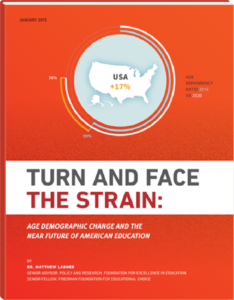
Back in 2015, I authored a study sounding the alarm regarding America’s changing age demography and how it would soon challenge K-12 education called Turn and Face the Strain. The basic case was that states face a gigantic increase in their elderly populations and a substantial projected increase in their K-12 populations, and the patron of state governments, the federal government, had huge unfunded liabilities. Eight years later, things are different than anticipated, and entirely worse.
If you want to start with the “good news,” which is actually bad, the country had a Baby Bust not reflected in the Census Bureau population estimates available in 2015. In the short term, smaller youth populations will relieve state financial burdens, but in the medium to long term, today’s youth population represents tomorrow’s working-age taxpayers. Limited youth translates into a limited future.
Now for the bad news: our federal government has exceeded previous records for fiscal irresponsibility. The federal government has been spending more than it takes in for decades, borrowing to make up the shortfall. During most of these recent decades, members of America’s massive Baby Boom generation were in their prime earning years, paying lots of taxes and saving for their retirement. Not coincidental to the rather alarming trend seen in the chart above, the average Baby Boomer reached the age of 65 in 2022. Right on cue:
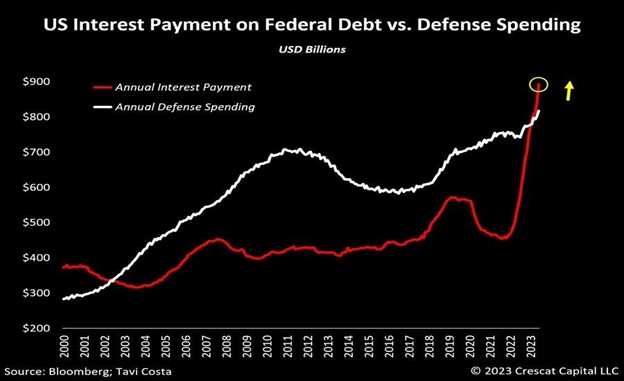
To be sure, there is more to the above trend than Baby Boomer retirement, including increased long-term interest rates and federal spending that would make inebriated sailors blush.
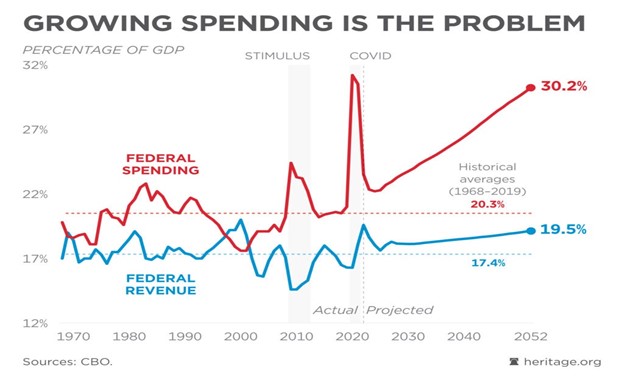
Meanwhile the march of Baby Boomer retirement continues unabated, with all surviving Boomers reaching the age of 65 by 2030. The federal government must roll over debt on an ongoing basis, and those super-low long-term interest rates are gone.
State and local governments primarily fund K-12, but this does not mean these larger trends will not affect them. State governments, for example, received 38% of their revenue from the federal government in fiscal year 2022, and the states are also in the health care financing business through the Medicaid program. Elderly people are heavy consumers of such health care, and every state is getting more and more elderly residents.
States face a short-run “fiscal cliff” with the expiration of COVID-19 relief money, but this is a minor concern in the grand scheme of things. Public schools never seemed to find much in the way of productive use for the funding in any case. The larger dynamic, however, is concerning. If the public school system presided over historic declines in achievement when possessed with more money than they ever expected, what will happen to academic achievement as the funding trend reverses? Is K-12 education doomed? I think not.

Arizona’s economy was drop-kicked with a steel-tipped boot during the Great Recession and saw some of the largest K-12 funding cuts in the country. Arizona students, however, were the only state student body to make statistically significant academic gains on all six NAEP exams given between 2009 and 2015.
During this period, Arizona lawmakers expanded scholarship tax credits and created the first education savings account (ESA) program. Charter school operators able to access capital during financial chaos found a once-in-a-lifetime (hopefully) opportunity to acquire campus space. This, in turn, created powerful incentives for districts to participate in open enrollment. Many high-demand schools replicated and expanded; low-demand schools saw their enrollments decline. It appears that Arizona families chose wisely overall.
The chart below is from different sources of data (linked state test data) from a different source (Stanford Educational Opportunity Project). It shows academic growth for low-income students from 2008 to 2018 by county. It shows the only Arizona county lacking above-average student academic growth (small and rural Greenlee-number 11 on the chart) had **cough** no charter or private schools.
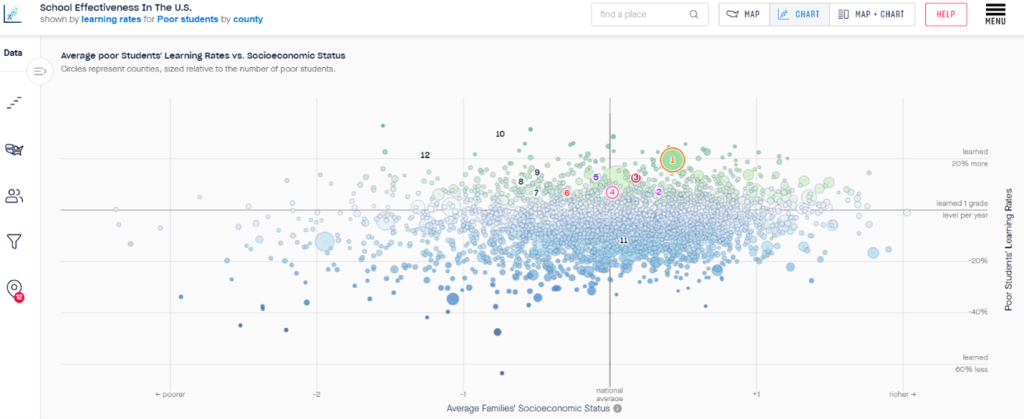
Can Arizona pull this off again? Only time will tell. High interest rates have slowed charter school construction, but microschools and ESAs have stepped into the breach. Is your state ready for the strain? Your time to prepare is running out quickly.
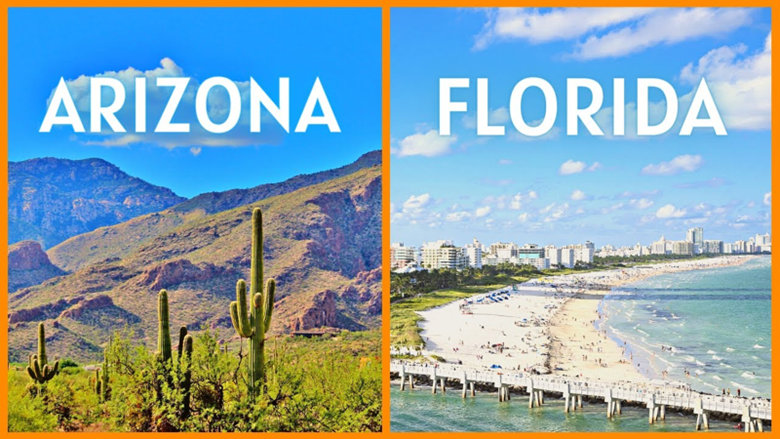
U.S. Supreme Court Justice Louis Brandeis coined the notion of American states serving as “laboratories of democracy” in New State Ice Co. v. Liebmann, a 1932 Supreme Court decision.
“A single courageous State may, if its citizens choose, serve as a laboratory; and try novel social and economic experiments without risk to the rest of the country,” Brandeis wrote.
With regards to education freedom, Arizona and Florida have been collaborative laboratories.
Arizona lawmakers created the nation’s first scholarship tax credit program in 1997. This law allows individual taxpayers to donate to a non-profit scholarship granting program and receive a dollar-for-dollar credit against state income taxes for the donation. A few years later, Florida lawmakers created the nation’s largest scholarship tax credit program.
In 1999, Florida lawmakers passed the McKay Scholarship Program, the nation’s first private choice program for students with disabilities. A few years later, Arizona lawmakers attempted to emulate the McKay program. Arizona choice opponents killed this program in the Arizona court system, prompting Arizona choice supporters to develop the nation’s first account-based choice program, the Empowerment Scholarship Account Program. Empowerment Scholarship Accounts withstood a court challenge, and a few years later Florida created what remains the nation’s largest account-based choice program.
Arizona and Florida’s innovators have learned and borrowed from each other. Thousands of unsung heroes from across the country also contributed to the development of this experiment, which remains ongoing. Teams in multiple states will work to optimize the use of accounts in a decentralized learning process. Oklahoma lawmakers have become the first state to adopt a large refundable tax credit for private education. This program likewise bears close examination over time; you never know what the next trend might go.

America has entered a difficult period with Baby Boomers exiting the labor market and a baby-bust diminished cohort of (mostly) their grandchildren entering the education system. Currently the baby bust is approaching the age of 16, so get used to seeing those “Help Wanted” signs. America’s two major political parties seem entirely incapable of reaching a consensus on reforming immigration. Something must give, but it remains unclear what it will be.
All of this is the background soundtrack to America’s public-school system as it grows increasingly dysfunctional and controversial. A complex web of local, state and federal authority attempting to govern a system of local monopolies marked by regulatory capture by unions and major contractors was also an experiment, but not a happy one. Our outcomes do not suggest that our experiment in bureaucracy represents the optimal method for educating students or in recruiting and fulfilling the aspirations of educators.
Our experiment in educational freedom must continue to conclude our experiment in educational frustration. Arizona and Florida have played crucial roles thus far, but new states have entered the collaboration. Young people are the future of any society, and they are getting to be in short supply. Some states are far more eager to give families a better return on their investment than others. America’s ongoing experiment with competitive federalism will soon merge with the experiment in educational freedom.

Faith Christian School in Mesa, Arizona, one of 447 private schools in the state serving more than 66,000 students, is committed to challenging children to grow as Christian servant-leaders so they can take their place as responsible members of the Kingdom of God.
Editor’s note: This article appeared Monday on dailycaller.com.
Newly-elected Democratic Arizona Gov. Katie Hobbs’ plan to undo the nation’s most expansive school choice program could affect thousands of students and families who are already utilizing the state’s voucher program, school choice advocates told the Daily Caller News Foundation.
Hobbs’ executive budget, released Jan. 13, asked state legislators to reverse the state’s expansion of its school choice program which currently allows all Arizona students in grades K-12 to receive taxpayer-funded vouchers if they choose to leave or are already outside of the public education system.
The proposal would have a severe negative impact on Arizona families already utilizing the school voucher program to pursue other educational opportunities, school choice advocates told the Daily Caller News Foundation.
“It’s an assault on the families and the parents,” Steve Smith, Arizona State Director of American Federation for Children, a group working toward school choice, told the DCNF. “Especially now when education options are needed more than ever in the wake of COVID-19. You must let these families flourish. These programs have been a lifesaver to so many and to take that away or even threaten to take it away, it’s just flat out wrong.”
In July, former Republican Arizona Gov. Doug Ducey signed a law creating the largest school voucher program in the country, making more than 1.1 million Arizona students in public and charter schools eligible to receive up to $7,000 in order to transfer schools. Under the previous program, disabled children, students living on American Indian reservations and students attending low-performing public schools were eligible for the taxpayer-funded vouchers.
As of Jan 9., more than 45,000 students have enrolled in the state’s school choice program, according to Faith Prep Arizona, a group that advises families using the school choice program. Originally just one-third of Arizona students were eligible for the program, with about 11,800 students enrolled, according to the AZ Mirror.
To continue reading, click here.
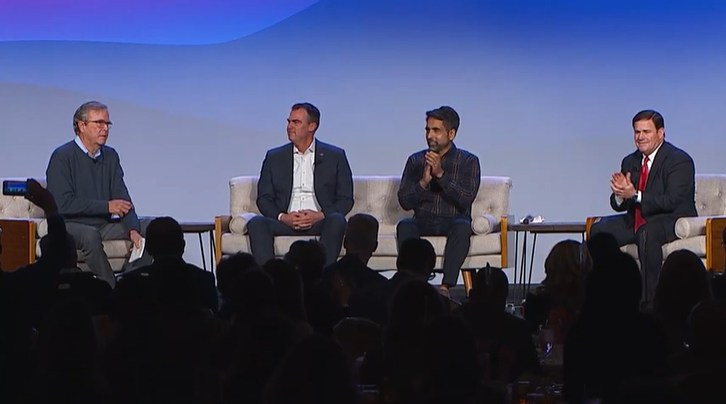
Former Florida Gov. Jeb Bush, far left, with Oklahoma Gov. Kevin Stitt, Kahn Academy CEO Sal Kahn, and Arizona Gov. Doug Ducey
Editor’s note: Former Florida Gov. Jeb Bush leads a discussion with Arizona Gov. Doug Ducey, Oklahoma Gov. Kevin Stitt, and Kahn Academy CEO Sal Khan for an inside look at the education innovations unfolding across the country.
In this video recorded as the keynote session at ExcelinEd’s recent education summit, Bush shines a light on Kahn World School’s groundbreaking partnership in Arizona with ASU Prep and the policies that can foster such innovations.
(You can read reimaginED senior writer Lisa Buie’s story about the partnership here.)
Bush also prompts Ducey and Stitt to discuss policy innovations unfolding in their states, how they overcame political obstacles, and their take on what the future holds for students and families.
You can watch the video here.
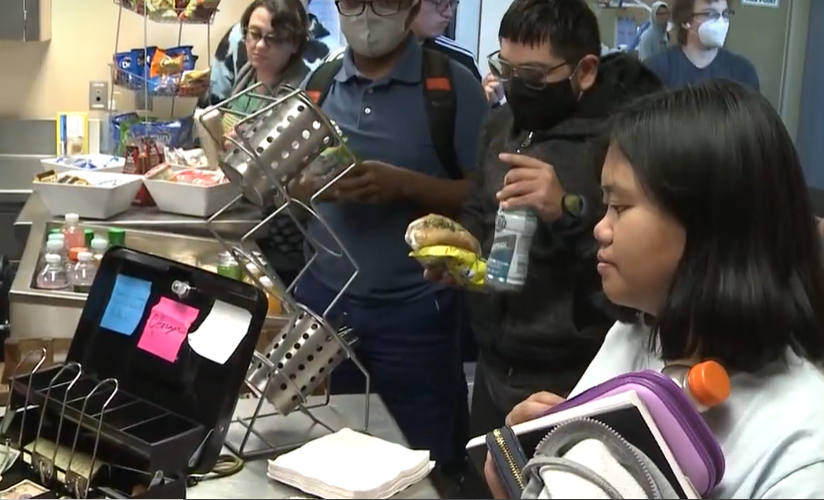
Gateway Academy is an accredited private day school for grades 6-12 that supports students with high functioning autism. Established in 2005, the school operates in an engaging, motivating, and personalized way that helps students build confidence and prepare for the future.
Editor’s note: This first-person essay from Arizona mother Shana Lockhart was adapted from the American Federation for Children’s Voices for Choice website.
When my son was in kindergarten, we were told he was one of many individuals born with high functioning autism. While not an official medical term or diagnosis, high functioning autism is an informal term used to talk about those on an autism spectrum disorder who can speak, read, write, and handle basic life skills.
Like all people on the autism spectrum, those who are high functioning have a hard time with social interaction and communication. They don’t naturally read social cues and might find it difficult to make friends. They don’t make much eye contact or small talk. They can get so stressed by a social situation that they shut down.
My son started school in a self-contained public school classroom for children with communication disorders. When he reached third grade, he was mainstreamed into a general education class. We had our challenges in those years, but I know that my son’s teachers did the best they could.
Things changed when he hit middle school. Like many pre-teens, he was plagued by those raging middle school hormones. Students like my son tend to react differently than other students when they hit puberty.
His social interactions, already somewhat strained, became more difficult as he entered high school, where the campus was large and crowded. He became overwhelmed. It wasn’t long before he began refusing to go to school.
We were at a loss to know what to do. His school wasn’t working for him, but we didn’t know if there was an alternative. Then I heard about Gateway Academy, a private school in Scottsdale for students with high functioning autism. We went on a tour and loved everything we saw and heard.
The only problem was a big one: We couldn’t afford the tuition.
I will be forever grateful that we learned at that point about Arizona’s education choice scholarship program, specifically, the Empowerment Scholarship Account program. It allows parents to opt their children out of public district or charter schools and receive a portion of their public funding deposited into an account for defined uses, such as private school tuition, online education, education therapies and private tutoring.
We filled out the paperwork and were so happy to learn we were eligible. I enrolled my son in Gateway Academy, which he would not have been able to attend otherwise. He is so happy there. The setting allows him to be as independent as he can be, which is so important for his self-esteem.
Gateway sees challenges as learning opportunities. Unfortunately, some schools see students with autism and other disorders as lost causes. But these children are bright, and they have beautiful souls. They may learn differently, but they are capable of learning. They have as much potential as any other child.
Sadly, a lot of these kids fall through the cracks in public schools. My other two children found our zoned public school a good fit, but that was not the case for my youngest. His needs were different, but he had just as much right to a great education as the children who thrive in public schools.
I’ve learned since receiving the Empowerment Scholarship Account that Arizona’s education savings account program was the first of its kind in the nation. As of Sept. 24, student eligibility is expanded to universal, meaning all families in the state can utilize this amazing resource.
I believe that all parents should be able to provide the right educational fit for their children, despite their financial situation. I’m grateful to live in a state that is forward thinking when it comes to education choice.
 Editor’s note: This commentary from Jonathan Butcher, the Will Skillman Fellow in Education at The Heritage Foundation and a reimaginED guest blogger, and Madison Marino, research associate and project coordinator at the Heritage’s Center for Education Policy, appeared Wednesday on washingtontimes.com.
Editor’s note: This commentary from Jonathan Butcher, the Will Skillman Fellow in Education at The Heritage Foundation and a reimaginED guest blogger, and Madison Marino, research associate and project coordinator at the Heritage’s Center for Education Policy, appeared Wednesday on washingtontimes.com.
Last summer, when Arizona Gov. Doug Ducey signed a law that made Empowerment Scholarship Accounts an option for all children in the state, special interest groups panicked.
Save Our Schools Arizona launched a referendum campaign, urging citizens to “vote for public schools” and support “our kids and our communities” by opposing the expansion. Yet SOS couldn’t gather enough signatures to put its proposal on the ballot.
It’s not that SOS didn’t have plenty of resources to qualify the measure. It’s just that families across the state think the accounts are what Arizona parents and students need.
“I’ve had so many conversations with neighbors and church friends, and it seems to come up everywhere,” said Annie Meade, mother of four and new account holder. “My neighbors who send their children to public school … are really happy for me to have more choices for my kids,” she said.
With Empowerment Scholarship Accounts, Ms. Meade and other participating families can use a portion of their child’s funds from the state K-12 education funding formula to purchase education products and services for their children. The money may be used to pay for online classes, textbooks, school uniforms, private school tuition, and more.
Ms. Meade will use accounts for three of her children and send her fourth to a charter school. The money will be used to pay tuition and expenses at a microschool, a small private school, along with curricular materials, music lessons and physical education classes.
To continue reading, click here.
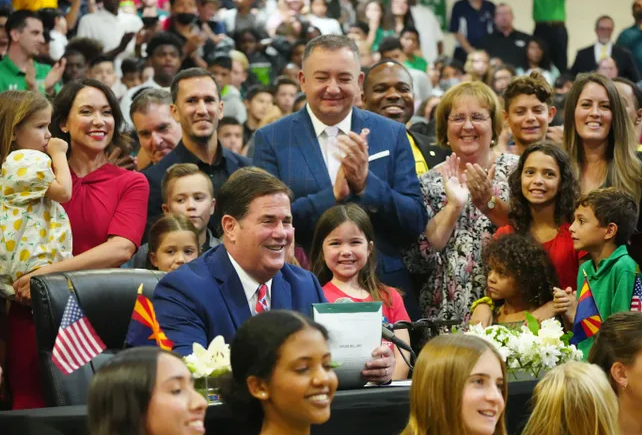
Arizona Gov. Doug Ducey signed HB 2853 at Phoenix Christian Prep in August.
Editor’s note: This article appeared last week on azcentral.com.
Over 10,000 applications for education savings accounts poured in over the course of less than a week, according to the Arizona Education Department.
As of Wednesday, the state had received nearly 22,500 universal eligibility applications, the Education Department said on Twitter. Arizona started accepting universal eligibility applications in mid-August, and the program was officially greenlit last week.
Those numbers show significant interest in the expanded ESA program, now the biggest of its kind in the nation.
The universal program provides families with funding that can be used for educational expenses outside of traditional district-run or charter schools, including private school tuition, curriculum, homeschooling and tutoring. The ESAs are expected to be worth about $7,000 per student, with some variability based on the applicant's district school and student characteristics.
All Arizona students are eligible to receive funding. Before the program was expanded by the Legislature this year, families could only apply if they met certain criteria and, in most cases, had been previously enrolled in a public district or charter school. Families with special education needs, foster families and military families were among the groups that could previously access Arizona's school choice program.
To continue reading, click here.
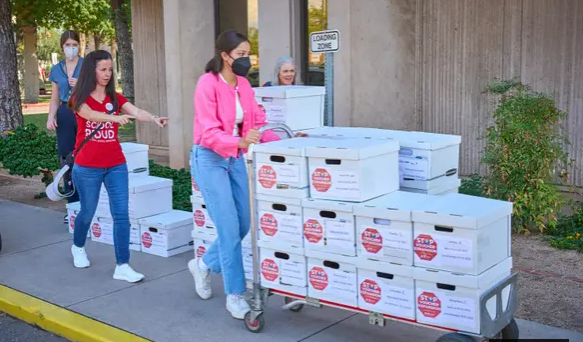
Members of Save Our Schools cart boxes of signed petitions to a storage room at the Arizona Capitol in Phoenix last week. The petition drive fell short of minimum signature requirements, so the program will roll out as planned. PHOTO: Alex Gould/The Republic
School choice expansion in Arizona became official last week with an announcement from Secretary of State Katie Hobbs that school choice opponents would not meet the minimum signature requirements to stop the program and send it to the ballot.
Hobbs, a Democrat running for governor who opposed the plan, said her office’s review of signatures came up short of the nearly 119,000 that were needed. Arizona’s Empowerment Scholarship Accounts Program now will be available to every student in the state.
Congratulatory remarks from school choice advocates, including leaders at the American Federation for Children, soon followed.
Statement from American Federation for Children CEO Tommy Schultz:
“Arizona is now the national standard-bearer for education freedom, and we’re thrilled to have stood behind Arizona parents and advocates for years as they achieved this resounding victory. Elected officials in every state should look to Arizona leaders like Gov. Ducey, Rep. Toma, and others for their political courage and look to follow their example.”
Statement from Arizona State Director of the American Federation for Children Steve Smith:
“Today marks the culmination of what thousands of families across the state have spent years fighting for. After several exceedingly challenging years with learning loss and grown-up politics getting in the way, the students have won. We are thrilled to know that all 1.1 million Arizona students will now have access to unlimited educational opportunities that school choice brings.”
Corey DeAngelis, a senior fellow at the federation, weighted in on Twitter, writing, “All Arizona families can now apply to take their children’s state-funded education dollars to the education providers of their choosing.”
Arizona Republican Gov. Doug Ducey, who championed the plan and signed it into law in July, also celebrated on Twitter, saying, “Let’s roll!” and “Parents prevail.”
Arizona’s education savings account program is now available for 1.1 million eligible families across the state, making Arizona the broadest school choice state in the nation. The program allows parents to receive scholarships by redirecting their current education tax dollars for expenses, such as private school tuition, resources for schooling at home, online curriculum, education therapies, tutoring, and more.
The ESA amount is expected to be approximately $7,000 per student per year.
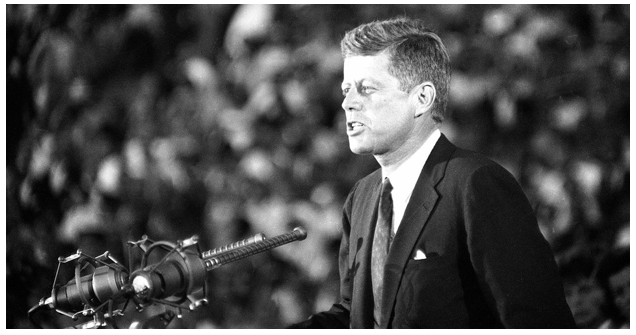 “Some would say that those struggles are all over, that all the horizons have been explored, that all the battles have been won, that there is no longer an American frontier. But I trust that no one in this assemblage would agree with that sentiment; for the problems are not all solved, and the battles are not all won; and we stand today on the edge of a New Frontier … ” – President John F. Kennedy
“Some would say that those struggles are all over, that all the horizons have been explored, that all the battles have been won, that there is no longer an American frontier. But I trust that no one in this assemblage would agree with that sentiment; for the problems are not all solved, and the battles are not all won; and we stand today on the edge of a New Frontier … ” – President John F. Kennedy
“Now this is not the end. It is not even the beginning of the end. But it is, perhaps, the end of the beginning.” – Winston Churchill
Those of us who believe in pluralism, diversity and variety in K-12 education have been thrilled since word leaked that Arizona choice opponents failed in their effort to kill the state’s Empowerment Scholarship Account Program expansion.
It’s now official: We have a choice program available to all school age children. This is a great achievement. We should celebrate and face future challenges with growing strength and enthusiasm.
Arizona’s program, and others like it perhaps to soon follow, are the next rather than the final milestone. The new frontier of the choice movement dawns on the horizon and will require still more sacrifice and toil to achieve.
That proposition: voluntary association and exchange should become a core principle of public education by putting all K-12 funding into parent directed accounts.
Much remains to debate and decide about such a system. How much extra funding should be given to different sorts of students? We’ve been using state K-12 funding formula weights as a default, but they aren’t stone tablets brought down from Mount Sinai.
What sort of supportive infrastructure in terms of information about service providers and navigation for parents should exist? What sort of technologies and practices are necessary to operate at truly universal scale?
I have opinions on these questions, but I don’t have answers. We are in the early stages of learning by doing in account-based education, which has been going on for barely over a decade at a small but growing scale. It will take toil, sweat, tears, and time to learn what we need to know.
Nevertheless, attendance boundaries and school assignment by default deserve a place in the dustbin of history right alongside other terrible practices of the past such as segregating schools by race and denying children with disabilities access to public schools.
With a great deal of hard work, future Americans may learn of all of these things, wince in disbelief, and ask their elders how it was possible that any of these horrible practices actually existed.
Purchased privilege reigns over our current K-12 system with an iron fist. Advantaged families buy homes zoned for high performing schools. They pay higher school taxes than most anyone in the world. They spend thousands of dollars annually on enrichment activities – tutors, camps, private lessons, college entrance exam test preparation, club sports and more.
Their reward for all of this investment: avoiding catastrophe but losing to Estonia on average.
A much grimmer prospect awaits American families who cannot afford hundreds of thousands in mortgage debt and thousands in annual enrichment spending. Locked out of high demand districts, unable to afford private school tuition, the failed promise of American public education has contributed to generational cycles of poverty.
Sen. John F. Kennedy’s acceptance speech in securing the Democratic nomination contains additional instruction for us today:
“We are not here to curse the darkness. We are here to light a candle. As Winston Churchill said on taking office some twenty years ago, ‘If we open a quarrel between the present and the past, we shall be in danger of losing the future.’ Today our concern must be with that future. For the world is changing. The old era is ending. The old ways will not do.”
Those words, spoken in 1960, roar into the present. The old ways in American K-12 education will not do. We indeed are in danger of losing the future. We cannot afford to mass produce illiteracy, innumeracy, and civic ignorance.
The future of American education must be pluralistic, diverse, and varied. We cannot afford to diminish potential by segregating with lines. Public funding is guaranteed in state constitutions, but there is no reason to structure the enterprise to rob families of agency and dignity.
It’s still early yet. Much work remains undone, many battles lie ahead. Nevertheless, the day is coming when our K-12 policies will respect the dignity of families to exercise autonomy in schooling. When that day comes, we will set the education default at families exercising their rights as free people.
For decades, we have claimed that minds are a terrible thing to waste. It is long past time to have our actions match our words. The edge of a new frontier of liberty lies within the reach of this generation.
We’ve all cursed the darkness long enough. Let us turn and light a torch of liberty.